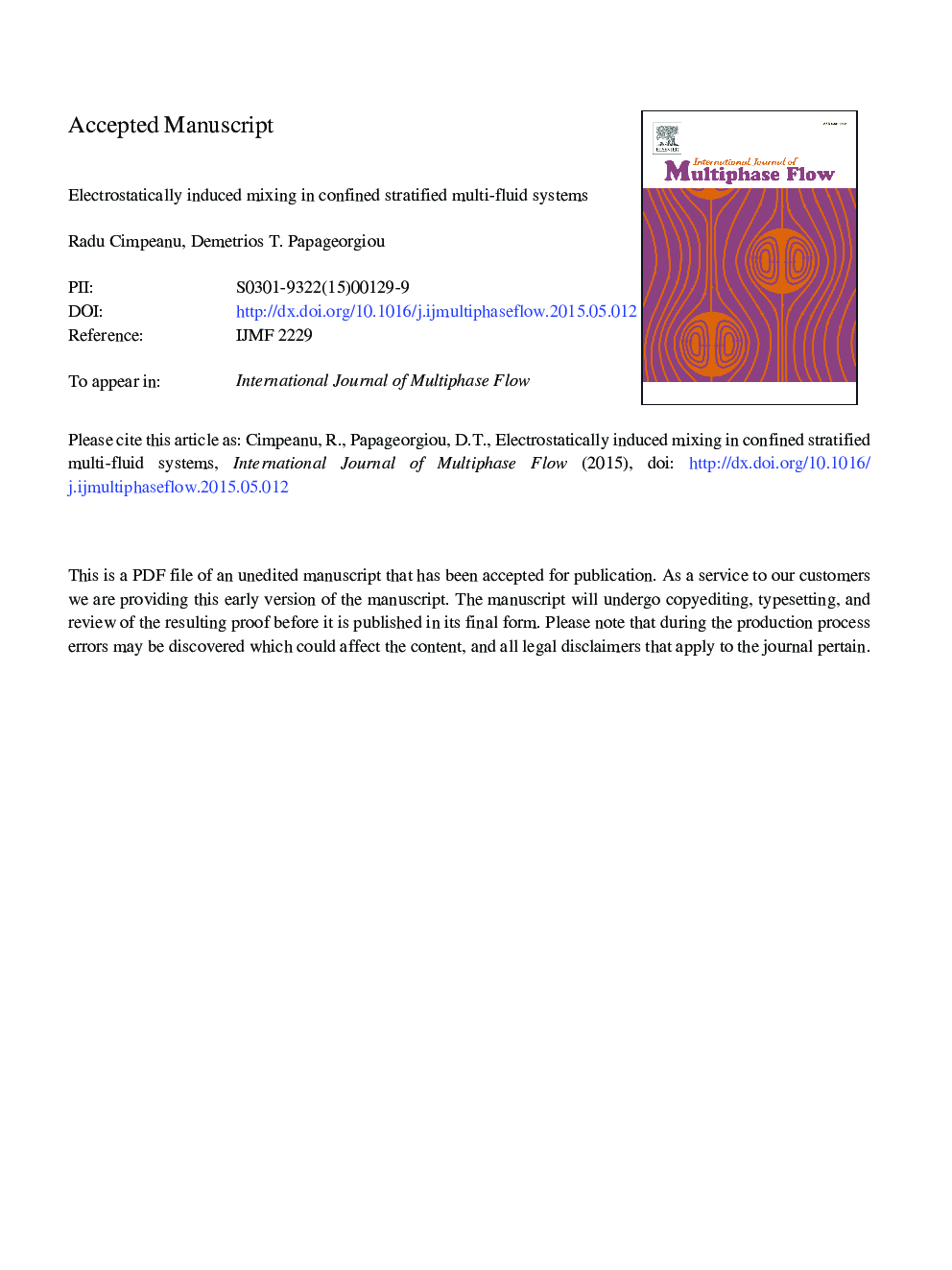| کد مقاله | کد نشریه | سال انتشار | مقاله انگلیسی | نسخه تمام متن |
|---|---|---|---|---|
| 667178 | 1458503 | 2015 | 27 صفحه PDF | دانلود رایگان |
عنوان انگلیسی مقاله ISI
Electrostatically induced mixing in confined stratified multi-fluid systems
ترجمه فارسی عنوان
اختلاط الکترواستاتیک منجر به سیستم های چند طبقه ای طبقه بندی شده محدود شده است
دانلود مقاله + سفارش ترجمه
دانلود مقاله ISI انگلیسی
رایگان برای ایرانیان
کلمات کلیدی
جریانهای متقابل، الکترو هیدرودینامیک، ثبات، مخلوط کردن، روش حجم مایع،
ترجمه چکیده
مکانیزم های کنترل الکترواستاتیک، طیف گسترده ای از فرایندهای صنعتی مدرن را از دستگاه های آزمایشگاهی بر روی یک تراشه به سنسورهای میکروفیلیس برای برنامه های امنیتی تأمین می کنند. در طی دهه های اخیر تاثیر قابل توجهی از دستکاری مایع مایع در زمینه هایی نظیر ساخت و ساز پلیمری، تولید میکرو و مخلوط کردن در رسانه های چسبناک، میدان مغناطیسی جریان الکتریکی را به عنوان ارزشمند ایجاد کرده است. این کار به بررسی ناپایداری های بین فازیکی ناشی از الکتروستاتیکی و ایجاد نسل بعدی ساختارهای یکپارچه غیرخطی در جریان های طبقه بندی نشده با غلظت، چسبندگی، دی الکتریک چند لایه محدود شده در کانال های دیواره هواپیما می پردازد. این مطالعه به طور تئوری نشان می دهد که عدم سازگاری بین فضایی می تواند برای رسیدن به مخلوط کارآمد در مناطق مختلف مایعات ناسازگار استفاده شود. این امر به وسیله الکترواستاتیکی جریانهای پایدار را به دور از حالت تعادلی خود انجام می دهد تا جریانهای نوسانگر زمان و بسیار غیر خطی ایجاد اختلاط تولید کنند. ناپایداری های الکترو هیدرودینامیکی غیر خطی نقش زمینه های زمینه ضریب اطمینان و یا حرکت قطعات دستگاه را در پروتکل های مخلوط کردن سنتی بازی می کنند. در ابتدا، پروتکل های ولتاژ ساده و در عین حال کارآمد در جریان ولتاژ مورد بررسی قرار گرفته و توزیع های ولتاژ متقارن تقسیم شده در نظر گرفته شده و نشان داده شده است که به میزان قابل توجهی افزایش سطح مخلوط حاصل می شود. هر جریان دو و سه بعدی، حاوی تنظیمات مایع واقع گرایانه (آب و روغن)، با استفاده از شبیه سازی های عددی مستقیم بر اساس معادلات ناجی-استوکس محاسبه می شود. چنین تحقیقات عددی مطالعه کمی جریان جریان را به رژیم کاملا غیرخطی تسهیل می کند و اساس روش های بهینه سازی را در زمینه کاربرد های مخلوط میکرو فلوئیدیک در هندسه های دو بعدی و سه بعدی تشکیل می دهد.
موضوعات مرتبط
مهندسی و علوم پایه
مهندسی شیمی
جریان سیال و فرایندهای انتقال
چکیده انگلیسی
Electrostatic control mechanisms underpin a wide range of modern industrial processes, from lab-on-a-chip devices to microfluidic sensors for security applications. During the last decades, the striking impact of fluid interface manipulation in contexts such as polymer self-assembly, micromanufacturing and mixing in viscous media has established the field of electrically driven interfacial flows as invaluable. This work investigates electrostatically induced interfacial instabilities and subsequent generation of nonlinear coherent structures in immiscible, viscous, dielectric multi-layer stratified flows confined in channels with plane walls. The present study demonstrates theoretically that interfacial instabilities can be utilized to achieve efficient mixing in different immiscible fluid regions. This is accomplished by electrostatically driving stable flows far from their equilibrium states to attain time-oscillatory and highly nonlinear flows producing mixing. The nonlinear electrohydrodynamic instabilities play the role of imposed background velocity fields or moving device parts in more traditional mixing protocols. Initially, simple yet efficient on-off voltage protocols are investigated and subsequently symmetry-breaking voltage distributions are considered and shown to considerably enhance the achieved level of mixing. Both two- and three-dimensional flows, containing realistic fluid configurations (water and oils), are computed using direct numerical simulations based on the Navier-Stokes equations. Such numerical investigations facilitate the quantitative study of the flow into the fully nonlinear regime and constitute the basis of optimization methods in the context of microfluidic mixing applications in two- and three-dimensional geometries.
ناشر
Database: Elsevier - ScienceDirect (ساینس دایرکت)
Journal: International Journal of Multiphase Flow - Volume 75, October 2015, Pages 194-204
Journal: International Journal of Multiphase Flow - Volume 75, October 2015, Pages 194-204
نویسندگان
Radu Cimpeanu, Demetrios T. Papageorgiou,
